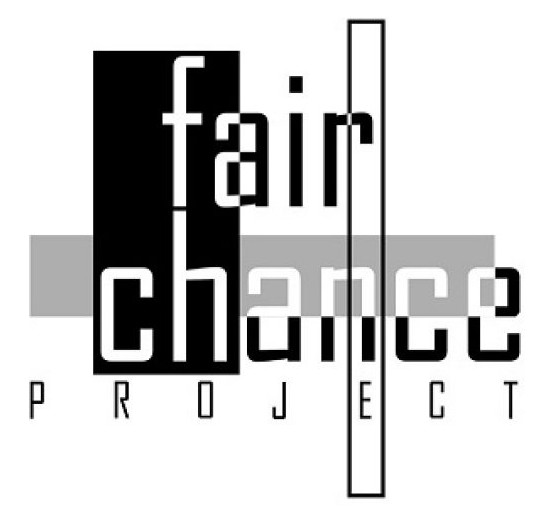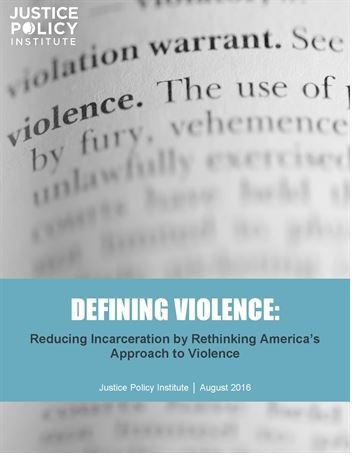Defining Violence: reducing incarceration by rethinking America’s approach to violence

Defining Violence: Reducing incarceration by Rethinking America’s Approach to Violence
A report by the Justice Policy Institute (JPI), August 2016
Read the whole report here.
SUMMARY
From the White House to statehouses around the country, there is more support than ever for criminal justice reform and efforts to reduce the imprisonment of more than 2 million people— what some call “mass incarceration.”
While the national conversation and policy reforms have focused on reducing the incarceration of people convicted of nonviolent offenses, just under half the people in prison have been convicted of a violent crime. It is impossible for the U.S. to be able to lower its incarceration rate significantly without changing how the justice system treats violent crimes.
There are signs that the justice reform approach may be broadening to include a different approach to violence. The 50-percent drop in the number of youth confined or placed out-of-the-home and reforms spurred on by the Supreme
Court around juvenile life without parole now mean that some young people convicted of violent crimes are at home, or are coming home, sooner. From California to Michigan to New York, changes to parole decisions are being offered to shift away from simply considering “the nature of the crime” to whether someone may reoffend if released.
Mandatory minimums sentences covering some violent offenses are being chipped away at. When faced with spikes
in violent crime, some city leaders are rejecting approaches that simply rely on enhanced penalties and are proposing to make bigger investments in communities where crime is a problem.
These modest steps are a starting place, but they need to be tempered with some realities: The latest surveys show only a 1 percent reduction in the national prison population along with a slight increase in jailed populations. The United States still has the highest incarceration rate and the largest prison population in the world. And many of the proposals that are pushing for a better approach to violence prevention were not enacted in 2016.
The data is clear: America will not significantly reduce incarceration unless the justice system changes its approach to violence. But this is a complicated political and systems reform issue.
When elected officials support bills that focus solely on nonviolent crimes, they can point to polling and voter- enacted ballot initiatives that show that the public supports their agenda. In some jurisdictions, policymakers have vocally rejected justice reform bills and ballot initiatives if there is a hint that someone convicted of a violent crime might benefit from the change. When people have been the victims of a violent crime, they may want to see that person locked up. And scholars have noted that if Americans want to treat the root causes of violence in the communities most affected by serious crime, it will require a significant investment of public resources—more than what we could currently “reinvest” from downsizing or closing prisons and jails.
To address this complicated issue, we need to unpack how the justice system responds to violent crimes, starting with how these crimes and behaviors are defined, and how that affects prison populations. Who defines a behavior as
violent, how the justice system treats these behaviors, and whether the approach to violent crime makes us safer needs to be scrutinized if we are ever going to make meaningful reductions in the use of incarceration.
In Defining Violence: reducing incarceration by rethinking America’s approach to violence, JPI looks more closely at:
– How violent offenses are categorized from place to place: An act may be defined as a violent crime in one place and as a nonviolent crime somewhere else. The law may define something as a nonviolent crime, but a corrections department may define the same behavior differently. For example, although burglary rarely involves person-to-person behavior, it is treated as a violent offense in some places and can lead to a longer prison sentence;
– How context matters in the way violent or nonviolent crimes are treated by the justice system: Sometimes a behavior that would not normally be defined as a violent crime or result in a long prison term can mean a much longer term of imprisonment when a gun is involved; and
– The disconnection between the evidence of what works to make us safer and our current policies: People convicted of some of the most serious offenses—such as homicide or sex offenses—can have the lowest recidivism rates, but still end up serving long prison terms.
In Defining Violence, JPI recommends a series of strategies for policymakers that come out of our work with justice systems, and our view of the policy reforms that are needed to shift the approach to violence, and achieve more significant reductions in the use of incarceration. JPI recommends that policymakers build their justice reform proposals around these principles:
Increase prevention and intervention approaches to violence;
Expand diversion without stringent offense prohibitions;
Reduce the number of offenses that can result in incarceration;
Reduce the number of offenses that result in criminal and delinquency proceedings;
Reduce the number of people on community supervision;
Change laws, policies, and practices that affect length of stay;
Increase restorative justice and trauma-informed approaches to violence;
Use risk assessment tools in decision-making;
Make prison and jail closures part of justice reform proposals; and
Reduce gun availability
Justice-Policy-Institute – Summary

